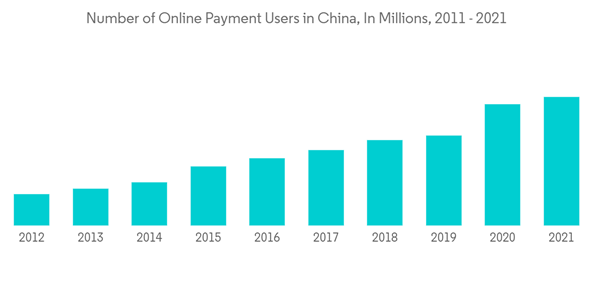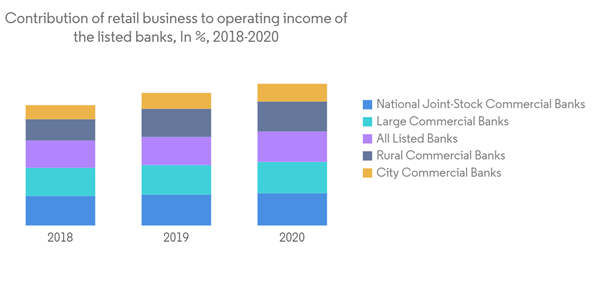As of January 1, 2021, Chinese banks are no longer obligated to set daily compounding interest rates for credit cards between 0.035% and 0.050%. Some banks now plan to lower rates or even undercut online lending rates, while others are looking at accepting higher-risk clients by charging them higher rates. The changes will guide more clients to the banking system, especially to local banks.
In 2020, the pandemic brought significant shocks to China's economic activities. The Chinese listed banks' success in navigating the operational disruption caused by the pandemic in 2020 is partly because they have continuously driven digital transformation and made steady progress over recent years.
Key Market Trends
Technology and Digitalization Trends are Driving the Market
China continues to be a world leader in e-commerce, digital payments, and digital banking. Since the outbreak of COVID-19, the banking sector in mainland China has significantly increased its focus and efforts on digital transformation. The banks that invested more heavily in technology and digitalization in the last couple of years are already starting to emerge as winners, as they were less impacted by the pandemic and better positioned to service their clients through digital channels and improve customer access and experience. In addition, many banks are increasingly leveraging fintech and emerging technologies, such as AI, data, cloud, and blockchain to transform their operating model enterprise-wide, increasing productivity and efficiency.
The Chinese government is also strongly promoting the digital economy. China is already essentially a cashless economy, with a large share of payments conducted through mobile phones and e-payment platforms such as WeChat Pay and Alipay. Recently, the People’s Bank of China launched a pilot of its own China Central Bank Digital Currency - the first in the world. The banking sector will need to step up its digital transformation efforts to adapt to the New Reality, maintain competitiveness and ensure long-term growth.
Retail Banking at the Listed Banks acted as a New Engine Driving Profit Growth in 2020
The Chinese banks have generally focused on retail banking in pursuit of strategic development. They tried to capture the leading positions in wealth management, private banking, and other business areas by driving the digital transformation of retail business through differentiated measures.
As of 31 December 2020, the total operating income of the listed banks’ retail business amounted to RMB 2,146.26 billion, growing by RMB 233.08 billion, or 12.18%, from 2019. The growth rate of the total operating income from the retail business of large commercial banks, national joint-stock commercial banks, city commercial banks, and rural commercial banks was 13.16%, 9.61%, 11.56%, and 7.58%, respectively, all higher than the growth rate in total operating income.
The proportions of operating income and profit before tax from the retail business of rural commercial banks increased significantly in 2020, while city commercial banks continued to rely more on corporate business or financial market business to generate profits.
Competitive Landscape
The report covers major international players operating in the Chinese retail market industry. In terms of market share, few major players currently dominate the market. However, with technological advancement and product innovation, mid-size to smaller companies are increasing their market presence by securing new contracts and tapping new markets.
Additional Benefits:
- The market estimate (ME) sheet in Excel format
- 3 months of analyst support
This product will be delivered within 2 business days.










